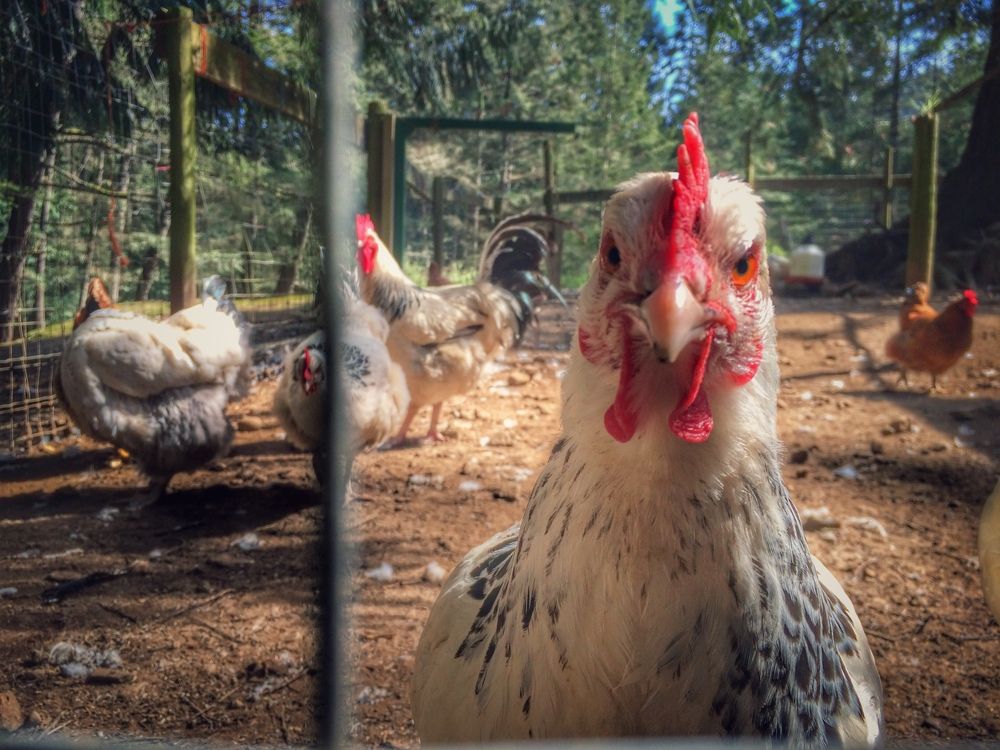Recently, we’ve seen the disastrous consequences of a failing food grid. If a simple virus causes this much disruption, what would happen in an apocalyptic event?
We wouldn’t have access to regular supplies of meat and eggs. We’d also be unable to purchase seed grains for feeding home-grown meat animals.
If you have a large chicken flock, they’d be left hungry. Hungry birds don’t lay, so your family would be without the protein sources they need to survive. It would be best if you had a sustainable solution even in times of crisis.
Recently, I’ve gained some knowledge about feeding and sustaining chicken flocks. When Covid-19 struck, I was incubating some Rhode Island Red eggs.
I’d never had a flock before and was woefully unprepared. I’d also only bought one 12 lb. bag of feed before feed stores locked down.
In this article, I’ll share what I’ve learned about feeding my flock. I’ll also discuss some ways to maintain chickens in a self-sufficient manner and feed your family.
Alternative Feeding Method #1 – Biodegradable waste
Vermont Compost’s Karl Hammer has a method of feeding 1,200 chickens without grain. They supply the birds with the tons of food waste they get from various institutions. Rather than eating all the food scraps at once, chickens work them into the compost and eat pieces over time, including bugs and grubs.
If the grids break down, there will be no garbage removal and you’ll have to manage your waste. On the other hand, you will need plenty of compost for your gardens. Chicken manure is an excellent source of plant-soluble nitrogen, and their habit of scratching also works perfectly for aerating compost.
With a chicken-centered composting system, you get the best of both worlds. Your chickens get fed, and you get the fertility of chicken compost.
Here’s how to set up a chicken-centric compost system to manage food waste.
Step 1: Build a Shelter for Your Chickens
However you keep them, chickens need cover. You could provide the chickens with a three-sided shelter where they can lay their eggs and get out of the elements.
If the coop is the primary means of predator protection at night, build a complete structure. You could use a barn-like building or create a design made mostly of hardware mesh.
A structure between 60 and 90 square feet offers housing for 30 chickens if they have an outside run. Provide two to three square feet per chicken inside the coop and four to six feet each in the run.
Step 2: Enclose Your Composting Areas
Your flock needs security, and you must ensure that they can’t leave their designated area.
Several fencing options are at your disposal but bear in mind that chickens are escape artists. If you keep the wing feathers trimmed on your flock, a fence six to eight feet high will suffice.
Chicken wire isn’t ideal for keeping predators out. Instead, use a solid wooden wall or something similar. Never build fences with spaces larger than two inches. One inch is better for bantam chickens or young birds.
If you choose wire fencing, use hardware mesh rather than chicken wire. Ensure that the bottom of the fence is secure, as many predators (and chickens!) are avid diggers. Bury your supports at least a foot deep, but preferably two, so that they’ll stand firm against the elements.
Step 3 – Set up Your Composting Area
When you plan your composting area, there are a few things to consider. Plan it so you can quickly move the finished compost to another space.
Being able to turn the compost easily is essential, so you have two options. The first is to build a couple of boxes or vats out of pallets or other scrap materials. Any type of large wooden container that the chickens can get into will do. Fill them from the bottom up and turn the compost once a week.
My personal preference is to create several compost heaps. Keep adding new scraps to the heap furthest from the compost removal area. As the chickens eat the leftovers and composting material, they turn it into beautiful compost.
When turning the heap, move the more refined stuff to the second heap. The chickens will still scratch and feed from this stack. Then, move the finest material from the second heap to the third when you turn them.
After a week or two, the material on the third heap will be ready to go to your compost processing area.
Step 4 – Feed Those Chicks!
Once your space is ready, start feeding your critters the composting materials. Follow many of the principles for a standard composting setup.
Feed them weeds from the garden, veggie extras, and fallen leaves. Add your kitchen scraps to that mix and any pests that you’ve dispatched (not with poison, of course). Other additives include manure from your larger livestock, wood chips, straw, and hay.
If you keep the food coming, you can feed your chickens excellently this way. A single chicken can process about a pound of composting materials daily, but they’ll eat as they need to and not all at once.
Alternative Feeding Method #2 – Free-Ranging
If you live in a safe area or provide a sizable fenced-in enclosure with many food opportunities, free-ranging is an option. While some people give their chickens access to an unlimited area, it’s a bad idea. These animals are wanderers by nature and may travel far from your property over time.
If you provide a large enough foraging area, your chickens can become almost self-sufficient. They’ll feed on small animals, plant material, and other forageable food sources.
Step 1 – Fence in the Chickens’ “Range”
Ensure that the zone you choose for your chickens has enough foraging area and consists of more than rocks and clay.
Chickens need access to soft soil for scratching and should also have access to many non-toxic plant materials. If you have an orchard, try using your chickens as a clean-up crew to eat the fallen fruits.
Step 2 – Give the Birds a Coop
Even free-range birds need a place to lay their eggs. Your coop can be a small home with many nest boxes or a large structure providing shelter from the elements. Ensure that the nests contain comfortable materials like hay or straw.
Step 3 – Watch Your Flock to Ensure They’re Getting Enough Feed
Not all birds take to free-ranging equally well. Some heirloom breeds are the best choice for free-range situations. Leghorns, Rhode Island Reds, and similar types are particularly useful in this type of situation (Damerow, 2017, 8-9).
If your flock doesn’t take well to this type of farming, you may have to supplement their feed. Consider combining this approach with the above and adding a compost heap to their range.
Even if your flock takes to ranging with enthusiasm, consider feeding the chickens your kitchen scraps or providing them with other food items to give them a boost.
Alternative Feeding Method #3 – Pasture-Raising
Pasture-raised flocks have been gaining popularity in recent years. If you live in an area rich in low-growing vegetation, it’s worth considering. Here’s how to successfully pasture-raise your flock.
Step 1 – Choose Between Tractors or Ranging Your Chickens
There are two main approaches towards keeping your flock on pasture. You can use a large, mobile structure or a movable fence.
Chicken tractors have an advantage because they’re an all-in-one system. The coop, run, and protection are combined into one structure. Its primary disadvantage is that you need to move it daily (Salatin, 1996, Chapter 10).
Keeping a large flock in one portable pen means the structure has to be colossal. If the tractor is too big, you’ll need a vehicle to move it.
Ranging chickens is advantageous because you can run your flock in the same location for multiple days. It’s also easier to move purpose-built fences.
The downside is that you need a separate mobile chicken coop for nights and egg-laying. You also need to release the flock every morning and put them away at night.
Step 2: Get Mobile Fencing or a Chicken Tractor
Once you choose a method, find the necessary materials. Many chicken tractor designs are available on the internet. Just adapt them to use what you have.
If you choose movable fences, you can buy an electric poultry fence from a supplier. If the infrastructure has fallen to pieces, this may be impossible.
You can build a serviceable electric poultry fence using chicken wire, jumper cables, and a car battery. It won’t be beautiful, but it will discourage the chickens from escaping. Beware, a DIY fence can give you quite a shock despite the low voltage.
Step 3: Position Your Tractor or Fencing on Your Target Area
Once you’ve acquired the appropriate tools, set up your feeding area. For a chicken tractor, hook it up to your vehicle and take it where you want it. Once you place the tractor, the chickens can start feeding.
Alternatively, place your portable coop or miniature tractor where you want the chickens. Next, put the fence around the flock’s foraging area and hook up the electricity.
Step 4: Manage the Flock
This system isn’t labor-intensive, and a well-managed setup should take less than 45 minutes a day. Move chicken tractors every 24-48 hours and fenced ranges every 3-4 days, depending on their size. Check daily to see whether the flock has enough feed and move them as required.
Considerations Beyond Basic Feeding
Living organisms have particular nutritional needs that must be met to keep them healthy. There are several substances that chickens can’t live without.
Protein
Full-grown layer hens require around 16% protein in their diet.
Free-ranged flocks naturally meet most of their own protein needs. However, with chicken composting or pasture-raising, you may need to supplement protein intake.
Consider cultivating mealworms, black soldier fly larvae, and other maggots to add protein. Plant-based protein sources include sunflower seed, beans, and other legumes.
Calcium
Calcium is essential but can cause problems if given in excess. Never mix the chickens’ calcium intake into a feed premix, as they can’t choose to eat only what they need.
If you have access to feed lime, offering a container of that to the chickens is a valuable calcium source. Oyster shell is another readily available option found at feed and pet stores.
Since it’s easily accessible and cuts waste, I prefer to bake eggshells and feed them back to the chickens. Gather eggshells for several weeks before processing them and giving them to the birds.
Phosphorus
Phosphorus is an often overlooked aspect of chicken diets due to the lack of understanding about how it works. Nevertheless, it’s an essential macronutrient (Blair, Robert. 2008. 36). Without a sufficient phosphorus source, hens are unable to metabolize the calcium they need for egg production. Beans, lentils, and soy are all excellent sources for occasional feeding.
Water
Chickens need constant access to water, so check their water sources daily. Adding crushed garlic cloves and apple cider vinegar to their waterers can help manage intestinal worm problems.
Conclusion
It’s never too late (barring death) or too early to become self-sufficient. When the world sinks into the abyss and infrastructures fail, are you prepared? Having a flock of chickens for eggs is a beautiful and profitable thing.
If you apply some of the ideas in this article, you can make your flock even more profitable! Why not get your birds used to some of the more sustainable feeding methods now?
Chickens that are used to alternative feeding methods will be easier to manage in an emergency. They’ll also cost you less, so you get more out of the deal.
Kick your sustainability game up a gear, and get prepared in the process. You can live without relying on external sources; you only need to start doing it.
Reference List
- Gail Damerow. 2017. Storey’s Guide to Raising Chickens. Storey Publishing LLC
- Joel Salatin. 1996. Pastured Poultry Profits. Polyface
- Robert Blair. 2008. Nutrition and Feeding of Organic Poultry. Storey Publishing LLC













































































This is all well and good for maybe 8 months of the year but how are we to maintain these chickens during the winter. We currently have a foot of snow on the ground. We still feed kitchen waste but with just two of us that doesn’t amount to much. I usually wait til winter to clean out my fridge and deep freeser but even with that there is not enough nuitrion to keep 20 birds going.
Would it be possible to prep now to store dry chicken feed and grain in vacuum sealed Mylar bags with an oxygen absorber sachet? Home canning of kitchen scraps and dispatched meal worms? Effort and expense now to ensure survival of chickens in troubled times would be really worth it since they provide a long term sustainable source of fresh, excellent quality, protein.
But to keep the flock going long term, you need a cockerel or two, which are very noisy enough to annoy your neighbours and advertise their presence for a far distance when it would be better to be more “low profile”. I prefer Quail because they are quiet enough to keep male birds too. A couple of cocks from unrelated bloodlines will allow you to incubate eggs to keep your flock self-sustaining itself or expand your flock. I keep four quail hens to one cock x 2.
My grandma used to tell me her mother and neighbours used mostly “boiled up potato peelings” to feed their hens during WWII in England food rationing time – but I can’t find any info on internet about it and she’s dead now so I can’t ask her for more details.
Thanks for your interesting and useful article
Another good article Michael.
My only concern that you didn’t cover is predators and roosters. If you want to keep your flock going, you need roosters. I think you get maybe 2 years of good egg laying for the hens, than it drops off. Roosters are needed to fertilize the eggs so you can have new chicks to keep the flock going. You will need more than one too. Predators will kill at least 2 birds a week on average if left to free range. The coop must be kept closed at night and well secured. If you get a coyote or fox in the coop, your pretty much done. Hawks are another predator to watch out for. You’ll never hear them either.
Great article! Thank you! One point about chicken manure compost – it is also high in phosophorus. For most regions it is desirable to add lots of phosphorus. However, some regions (for example, Kentucky’s Bluegrass region) have naturally high phosphorus soils. You can ruin your soil by exceeding the soil phosphorus content of the plants that you want to grow. The soil should be tested before adding any fertilizer or amendments like compost. You can get a soil test at your county cooperative extension office or buy a home test kit.
Hi, guys and gals i love this site/page. There is so much info on here it’s unreal it’s better than most survival pages i have looked at through the years and it keeps me coming back for more. I love prepping so much it gives me a buzz knowing that my family will be better off than most. Just take covid for instance. Everyone used to laugh at me for stockpiling food, medical supplies and so on but it turned out very handy as the food lasted well over three months throughout the virus. And all those that laughed at me basically patted me on the back lol. We don’t get many preppers here in the UK (compared to the US) but this site has great info. More than i will get here in the UK. So keep these survival articles coming. And even the comments section is quite informative. Great work guys!